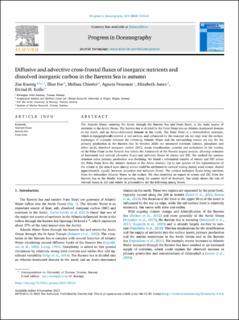| dc.description.abstract | The Atlantic Water, entering the Arctic through the Barents Sea and Fram Strait, is the main source of nutrients in the Arctic Ocean. The Barents Sea is divided by the Polar Front into an Atlantic-dominated domain in the south, and an Arctic-dominated domain in the north. The Polar Front is a thermohaline structure, which is topographically-steered at sub-surface, and influenced by the seasonal sea ice edge near the surface. Exchanges of nutrients between the inflowing Atlantic Water and the surrounding waters are key for the primary production in the Barents Sea. In October 2020, we measured nutrients (nitrate, phosphate and silicic acid), dissolved inorganic carbon (DIC), ocean stratification, currents and turbulence in the vicinity of the Polar Front in the Barents Sea within the framework of the Nansen Legacy project, allowing estimates of horizontal and vertical advective fluxes and turbulent fluxes of nitrate and DIC. We studied the autumn situation when primary production was declining. We found a substantial transfer of nitrate and DIC across the Polar Front from the Atlantic domain to the Arctic domain. Up to one quarter of the replenishment of the nitrate in the mixed layer during winter could be attributed to vertical mixing during wind events, shared approximately equally between advective and turbulent fluxes. The vertical turbulent fluxes bring nutrients from the subsurface Atlantic Water to the surface. We also identified an export of nitrate and DIC from the Barents Sea to the Nordic Seas occurring along the eastern shelf of Svalbard. Our study shows the role of vertical fluxes in fall and winter to precondition for the following spring bloom. | en_US |
